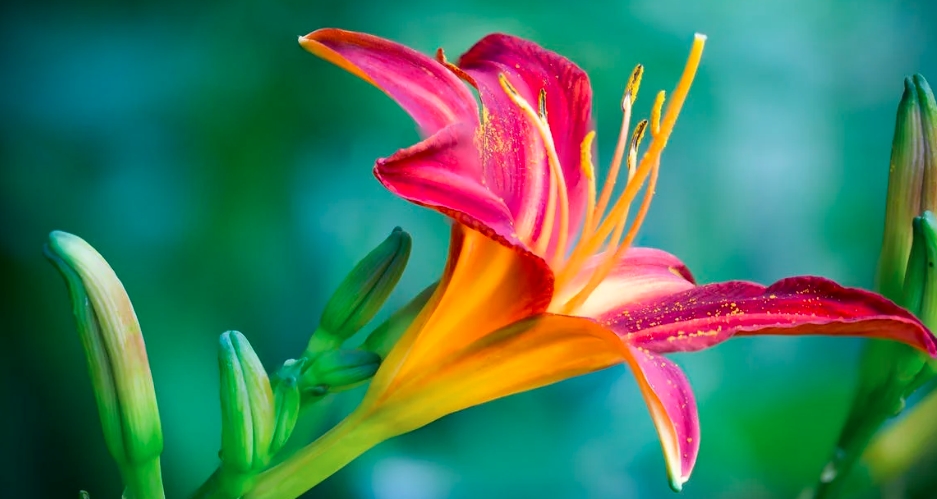Creating a beautiful flower garden is an incredibly rewarding task. A flower garden can be the perfect way to add a touch of color and life to any outdoor space. Not only is it a great way to express your style and creativity, it can also bring a sense of calm and relaxation to your life. Flowers are known to be mood-enhancing and can even help reduce stress levels. For these reasons, flower power is an important part of creating a beautiful garden.
Gardening has been linked to positive mental health outcomes, including improved mood and stress reduction. Studies have shown that taking part in activities such as gardening can be more beneficial than simply taking a break from work. Gardening can provide an opportunity to connect with nature and get away from the hustle and bustle of everyday life. Not only that, but it also allows you to use your hands and be creative. It’s an opportunity to create something beautiful and make something out of nothing.
The beauty of a flower garden is that it can be as big or as small as you like. Whether it’s a few potted plants on a balcony, or a sprawling garden filled with vibrant blooms, the possibilities are endless. With a bit of planning, some basic gardening knowledge and a little bit of effort, anyone can create a stunning flower garden. So, don’t be afraid to embrace your inner flower power and create something special.

Planning Your Flower Garden
Choosing the Right Location:
The right location for a flower garden is essential for it to thrive. When selecting a location, consider the amount of sunlight the garden will receive, as well as the type and amount of precipitation. Additionally, consider the proximity of nearby trees, shrubs, and other plants, which can provide shelter and protection. Lastly, take into account how often the garden will be watered and the amount of soil needed to maintain the flower beds.
Deciding on the Size and Shape of Your Garden:
The size and shape of a flower garden will depend on the space available and the desired results. Consider the size of the plants that will be used, as well as the shape of the flower beds. In addition, think about the types of flowers that will be planted and the amount of time and effort needed to maintain the garden.
Factors to Consider when Choosing Plants:
When selecting the plants for a flower garden, several factors should be taken into account. First, consider the climate and temperature of the garden’s location. Additionally, look at the type of soil that is present and determine which plants will be best suited for the environment. Lastly, think about the amount of sunlight and water needed to maintain the plants.
Understanding Soil and Drainage:
Soil and drainage are two of the most important factors in creating a successful flower garden. The soil should be well-drained, with a deep enough layer of topsoil to provide adequate nutrients for the plants. Additionally, a soil test should be performed to evaluate the pH level and nutrient content of the soil. Furthermore, proper drainage should be ensured to prevent the roots of the plants from becoming waterlogged.
Choosing the Right Flowers
Annuals vs. Perennials:
a. Annuals: Annuals are plants that complete their life cycles in one growing season. They are ideal for beginners as they require minimal care and can be planted at any stage of the year. Additionally, they are also cheaper than perennials and can be easily replaced each year.
b. Perennials: Perennials are plants that live for many years and tend to come back year after year. They are more expensive than annuals, but they can provide long-term color and beauty to the garden. They will often require more maintenance than annuals, but they can also be very rewarding.
Best Flowers for Beginner Gardeners:
a. Marigolds: Marigolds are a great choice for beginner gardeners as they are easy to grow and require minimal care. They come in a variety of colors and sizes, and they are also very pest-resistant.
b. Zinnias: Zinnias are another great choice for beginner gardeners. They are easy to grow and require minimal care. They come in a variety of colors and sizes, and they are also very drought-resistant.
c. Sunflowers: Sunflowers are a great choice for beginner gardeners as they are easy to grow and require minimal care. They come in a variety of colors and sizes, and they are also very pest-resistant. They will also attract birds and other wildlife to your garden.
Matching Flowers to Your Garden’s Conditions:
a. Climate: The climate of your garden will determine which flowers will thrive in it. Make sure to choose flowers that are suited to your climate and will be able to withstand the temperatures and rainfall of your area.
b. Soil: The soil type in your garden will determine which flowers will be able to thrive in it. Make sure to choose flowers that are suited to your soil type and will be able to tolerate the pH level and drainage of your soil.
c. Sunlight: The amount of sunlight your garden receives will determine which flowers will thrive in it. Make sure to choose flowers that are suited to your amount of sunlight and will be able to tolerate the amount of direct sunlight or shade they will receive.
Creating a Color Scheme:
a. Color Wheel: Using the color wheel can help you create a beautiful and harmonious color scheme for your garden. Start by choosing one color as the main hue and then choose colors that complement it.
b. Contrast: Contrasting colors can also be used to create a striking and vibrant color scheme in your garden. Choose colors that are opposite on the color wheel and combine them for a bold and beautiful effect.
c. Blending: Blending colors can also create a beautiful and unified theme in your garden. Choose colors that are close to each other on the color wheel and combine them for a subtle and harmonious effect.
Planting Your Garden
Outline Planting Your Garden
1. Prepare the Soil: Preparing the soil for planting your garden is a crucial step that should not be overlooked. It is important to ensure that the soil is free from weeds and has a good mix of nutrients. You can prepare the soil by removing any large stones, roots, or weeds, as well as adding compost or manure to enrich the soil.
2. When to Plant: The best time to plant your garden depends on the type of plants you will be growing. Generally, you should wait until the last frost of the season has passed, as this will ensure that your plants are not damaged by cold temperatures. Additionally, it is important to check the soil temperature before planting to ensure that the plants will have the right conditions to grow.
3. Planting Techniques: When planting your garden, it is important to select the right plants for the environment and to ensure that they are placed in the right location. Additionally, you should use the correct spacing between plants and ensure that the plants are planted at the right depth. Finally, it is important to water the newly planted seeds and plants thoroughly.
4. Watering and Fertilizing: After planting your garden, it is important to keep it well-watered and nourished. Depending on the type of plants, you should water them once or twice a week, ensuring that the soil is not too wet or dry. Additionally, it is important to fertilize your plants regularly to ensure that they are getting the nutrients they need to thrive.
Maintaining Your Flower Garden
1. Pruning and Deadheading: Pruning is an essential part of flower gardening and should be done regularly to encourage healthy growth and flowering. Deadheading is the process of removing wilted blossoms to prevent seed formation, encouraging further blooms and keeping the plants looking neat. Pruning and deadheading should be done frequently, particularly during the growing season, and before the onset of winter. Pruning should be done with the right tools, and should be done in the right way to ensure that the plant is not damaged.
2. Pest and Disease Control: Pests and diseases can be a major problem for flower gardens, so it is important to keep an eye out for them. Common pests include aphids, slugs and caterpillars, while common diseases include rust, powdery mildew and black spot. Keeping the garden clean and tidy, and regularly checking the plants for signs of pests and diseases can help to keep them at bay. Using an appropriate pesticide or fungicide can also help to control the pests and diseases.
3. Watering and Feeding: Watering and feeding are important to ensure that flowers are healthy and thriving. Watering should be done regularly, and the amount of water needed will depend on the type of plant and the climate. Feeding should be done in spring and summer, and a general purpose fertilizer should be used.
4. Winterizing Your Garden: Winterizing your garden is important to ensure that flowers are protected from the cold and frost. It is best to do this in autumn, when the days are still warm but the nights are cooler. Mulching and covering the plants with a protective layer of material such as straw can help to protect them from the cold. It is also important to prune back any dead or diseased foliage and to remove any weeds.
Garden Design Tips
1. Creating Focal Points: Focal points are a great way to draw attention to certain areas of your garden. They can be created in a variety of ways, such as by using plants of different shapes, sizes, and colors, or by adding garden structures such as trellises, arches, or sculptures. Additionally, focal points can be created by incorporating water features, like ponds or waterfalls, or by creating a seating area in a prominent spot in the garden.
2. Using Containers and Raised Beds: Containers and raised beds are great for adding color and texture to your garden, as well as for creating a more organized and structured look. Containers can be placed on patios, decks, or anywhere in the garden, and come in a variety of shapes and sizes. Raised beds are useful for planting vegetables, herbs, and flowers, and can be constructed from a variety of materials.
3. Creating a Themed Garden: A themed garden can be an enjoyable and creative way to express yourself. You can create a garden based on a particular theme, such as a Japanese garden, a Mediterranean garden, or a tropical garden. When creating a themed garden, be sure to choose plants, furniture, and decorations that will suit the theme. Additionally, you can incorporate elements such as water features, pathways, and garden structures to further enhance the theme.
4. Incorporating Garden Structures: Garden structures, such as trellises, pergolas, and arches, can be used to create a sense of structure and order in your garden. Additionally, they can be used to provide privacy, shade, and even visual interest. Be sure to choose garden structures that match the style of your garden and that will be suitable for your climate.

Troubleshooting Garden Problems
Common Garden Problems and Solutions
Common garden problems include weeds, plants that don’t thrive, pests, and diseases. To troubleshoot these problems, gardeners must first identify the source of the issue. Once the source has been identified, the best solution can be found. Some general tips for troubleshooting garden problems include: removing weeds, providing adequate sunlight, checking soil pH and fertility levels, and using proper watering techniques.
Dealing with Plant Diseases and Pests
Plant diseases and pests can be difficult to identify and can cause major destruction in a garden. To prevent and treat plant diseases and pests, gardeners should inspect their plants regularly, looking for signs of infection or damage. Once the source of the problem has been identified, the appropriate treatment can be applied. Common treatments for plant diseases and pests include natural remedies such as neem oil, insecticidal soaps, and beneficial insects.
Identifying and Correcting Soil Issues
Soil issues, such as poor drainage, compacted soil, and nutrient deficiencies, can be difficult to identify and can cause major problems for plants in a garden. To identify soil issues, gardeners should examine the soil for signs of compaction or poor drainage. Once the source of the problem has been identified, the appropriate solution can be found. Common solutions for soil issues include adding organic matter, aerating the soil, and adding sand or gravel for better drainage.
Preventing and Treating Plant Stress
Plant stress can be caused by a variety of factors such as too much or too little water, excessive heat or cold, and nutrient deficiencies. To prevent and treat plant stress, gardeners should ensure that their plants are receiving enough water, light, and nutrients. If a plant is already stressed, gardeners should look for signs of damage or infection and treat the plant with the appropriate remedy. Common remedies for plant stress include providing extra water, applying fertilizer, and providing shade or protection from extreme temperatures.
Conclusion
Flower Power has been an enlightening journey. It is a reminder that beauty can be found in the most unexpected places. We have explored the many ways to create a beautiful flower garden, from selecting the right plants to choosing the perfect location. We have also discussed the importance of proper maintenance and care for our flowers in order to keep them looking their best. With the right knowledge and effort, anyone can have a stunning flower garden that will be the envy of the neighborhood. So take the time to learn about gardening and start creating your own flower power today!
FAQs
1. What is Flower Power?
Flower Power is the power of flowers to bring beauty and life to any outdoor space. It is the idea that by planting and caring for flowers, you can create a beautiful garden of your own.
2. How do I start a flower garden?
Starting a flower garden is easy and fun. First, choose an area of your yard that gets plenty of sun and has good drainage. Next, decide what type of flowers you want to plant. Consider their bloom time, color, and height. Finally, choose the appropriate soil and fertilizer to help your flowers grow.
3. What are the best flowers for a flower garden?
The best flowers for a flower garden depend on the climate and region you live in. Some popular choices are roses, daisies, tulips, sunflowers, lilies, and daffodils. Also consider native plants native to your area.
4. How do I keep my flower garden looking beautiful?
To keep your flower garden looking beautiful, water regularly and mulch the soil to help retain moisture and reduce weeds. Deadhead spent blooms and prune plants to encourage new growth. Make sure to fertilize your plants during the growing season and apply insecticides as needed.
5. What are the best tips for designing a flower garden?
When designing a flower garden, think about the overall look and feel that you want to create. Choose plants that complement each other in terms of color, texture, and size. Plant in groups of three or more for a balanced look. Incorporate pathways, benches, and other elements for a more inviting space.
6. How do I choose the right plants for my flower garden?
Choosing the right plants for your flower garden is key to a successful garden. Consider your climate and soil conditions, as well as the amount of sun and shade the area receives. Also think about how much space you have and how often you want to tend to your plants.
7. How do I maintain a healthy flower garden?
To maintain a healthy flower garden, water regularly and fertilize your plants. Remove weeds and deadhead spent blooms. Prune plants as needed and mulch the soil to retain moisture and reduce weeds. Make sure to apply insecticides as needed.
8. What are the best flowers for beginner gardeners?
For beginner gardeners, some of the best flowers to start with are sunflowers, daisies, daffodils, pansies, and marigolds. These flowers are easy to care for and can tolerate a variety of growing conditions.
9. How do I choose the best soil for my flower garden?
Choose a soil that is well-draining and nutrient-rich. Consider adding compost or other organic matter to improve drainage and provide essential nutrients for your plants. Also think about the pH level of the soil, as some plants prefer acidic or alkaline soil.
10. What are the best flowers for attracting butterflies and hummingbirds?
Some of the best flowers for attracting butterflies and hummingbirds are lantana, butterfly bush, bee balm, salvia, and cosmos. These flowers produce nectar that is attractive to these pollinators. Plant these flowers in sunny areas and water regularly.

















